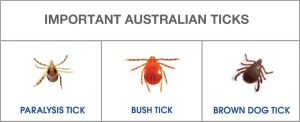Paralysis ticks are a significant threat to pets in Australia, particularly along the east coast where the climate is warm and humid. The South Coast of NSW is a particular hotspot for ticks, with thousands of pets requiring treatment every year. If you take your pet on holidays, make sure you research whether or not it is a tick hotspot and use preventative products for the duration of your time spent there.
These tiny parasites can cause severe illness and even death in dogs, cats, rabbits and most domestic species. Native animals are immune to the tick toxin, and are part of the lifecycle of the paralysis tick – allowing them to mature and passing them on to attach to animals like dogs to complete the cycle.
This article will cover the signs and symptoms of tick paralysis, prevention strategies, treatment options, and effective preventative products like Nexgard, Bravecto, and Simparica.
Identification of Paralysis Ticks


Paralysis ticks (Ixodes holocyclus) can be identified by their distinct physical characteristics:
- Size: Adult ticks are approximately 3-6mm in length, but can be bigger when fully engorged.
- Color: They have a grey body with legs close to the head. The legs are the feature that best distinguishes them from other ticks in the same regions. Paralysis ticks have one pair of brown legs closest to their head, then two pairs of white legs, and then one pair of brown legs closest to the body.
- Shape: They have an oval or seed-shaped body that is flat when empty, or rounded when engorged.
- Mouthparts: They possess a long mouthpiece or ‘snout’ with barbs along it, helping them to embed within their host. When removing ticks, it is important to make sure this part is also extracted.
Paralysis ticks are commonly found in bushy, grassy areas and can attach to pets when they brush past vegetation where the tick is waiting.
Signs and Symptoms of Tick Paralysis
Paralysis ticks (Ixodes holocyclus) inject a potent neurotoxin while feeding on their host’s blood, leading to a range of symptoms. Early signs of tick paralysis in pets include:
- Lethargy
- Loss of appetite
- Weakness or wobbliness in the hind legs – ascending paralysis
- Difficulty breathing
- Change in bark or meow
- Vomiting
As the condition progresses, pets may experience more severe symptoms such as:
- Complete paralysis
- Difficulty swallowing
- Respiratory distress
If you notice any of these symptoms, it’s crucial to seek veterinary attention immediately.
Prevention Strategies
Preventing tick bites is the best way to protect your pet from tick paralysis. Here are some effective strategies:
- Avoid Tick-Infested Areas: Keep your pets away from bushy, grassy areas, especially during tick season (spring and early summer).
- Regular Tick Checks: Perform daily tick checks on your pets, focusing on areas like the head, neck, and ears.
- Regular Grooming: Regular grooming and bathing can help you spot ticks early. Using a fine-toothed comb can also help in detecting ticks.
- Use Tick Preventatives: Apply tick prevention products at the recommended times, and always repeat doses on time. Set a reminder or mark it in your calendar.
- Tick Season: Paralysis ticks are most active during the warmer months, particularly from spring to early summer. Being extra vigilant during these times can help prevent tick bites.
- Yard Maintenance: Keeping your yard well-maintained by regularly mowing the lawn, trimming bushes, and removing leaf litter can reduce tick habitats around your home.Tick
- Removal Kit: Keep a tick removal kit handy, including tweezers or a tick twister, antiseptic, and a container to save the tick for identification if needed.
Treatment Options
If your pet is bitten by a paralysis tick, immediate veterinary care is essential. Treatment options may include:
- Tick Removal: Removal of the tick using tweezers or a tick twister.
- Antitoxin Serum: Administering an antitoxin serum to neutralize the tick’s toxin – some pets can have a reaction to this medication, so they will be monitored closely.
- Supportive Care: Providing oxygen therapy, intravenous fluids, and medications to support breathing and other bodily functions. The bladder will be affected by the tick toxin causing paralysis, so it will need to be expressed regularly.
Advanced cases of tick paralysis may need to be placed on a ventilator to assist breathing. At this stage, recovery is unlikely.
Preventative Products
Several effective products can help protect your pets from paralysis ticks. Here are some commonly used examples:
- Nexgard: This is available as a chewable tablet for dogs, and provides protection against paralysis ticks for up to 5 weeks. It works by killing ticks within 24 hours of attachment. The feline version is a topical treatment.
- Bravecto: Available as a chewable tablet for dogs or spot-on treatment for cats and dogs, Bravecto offers up to 4 months of protection against ticks. It kills ticks by disrupting their nervous system.
- Simparica: This chewable tablet for dogs starts killing ticks within 8 hours and provides protection for up to 35 days.
By using these preventative products and following the recommended prevention strategies, you can significantly reduce the risk of tick paralysis in your pets. Prevention is key, as recovery can be expensive and very difficult on your pet – and some pets die despite the best treatment.
Paralysis ticks pose a serious threat to pets in Australia, but with vigilance and the right preventative measures, you can keep your furry friends safe. Regular tick checks, avoiding tick-prone areas, and using effective tick prevention products are key to protecting your pets from this dangerous parasite.
If you have any concerns or notice symptoms of tick paralysis in your pet, consult your veterinarian immediately. Your prompt action can make all the difference in ensuring your pet’s health and well-being.
Pickle’s Pet Care 2024
Written by Brittany Overton – Veterinary Nurse

